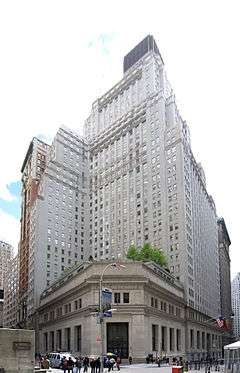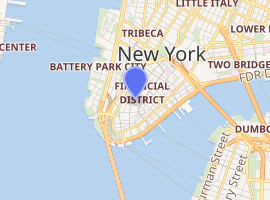15 Broad Street
15 Broad Street (formerly known as the Equitable Trust Building) is a former office building in the Financial District of Manhattan, New York City, that has been remodeled and now contains luxury apartments. It is located on the eastern side of Broad Street between Wall Street and Exchange Place with entrances at 51 Exchange Place and 37 Wall Street. In 1931, it made the list of the 20 largest office buildings in the world.[2]
| 15 Broad Street | |
|---|---|
 Seen in the background; the smaller building in front at the street corner is 23 Wall Street | |

| |
| Former names | Equitable Trust Building |
| Alternative names | Downtown by Philippe Starck |
| General information | |
| Architectural style | Neoclassicism |
| Location | Financial District, Manhattan, New York City |
| Address | 15 Broad Street, New York, NY 10005 |
| Coordinates | 40°42′24″N 74°0′38″W |
| Completed | 1928 |
| Renovated | 2005 |
| Height | 551 feet (168 m) |
| Technical details | |
| Floor count | 43 |
| Design and construction | |
| Architecture firm | Trowbridge & Livingston |
| References | |
| [1] | |
History
Construction: 1928
The building was built in the neoclassical style for the Equitable Trust Company and was therefore called the Equitable Trust Building.[2] Replacing the Mills Building and another building on the site, it was completed in 1928. The Equitable Trust Co. was one of the units of the Chase National Bank organizations, one of the largest and most powerful banking institutions in the world at the time. The law firm Davis Polk & Wardwell was located in the predecessor building from around 1889 and moved out when it was demolished, but returned to the address into the newly completed building and stayed there until 1959.
The architects were Trowbridge & Livingston, who also drew plans for the Bankers Trust Co., the New York Stock Exchange extension, Bank of America, and the Equitable Trust Building's adjacent J. P. Morgan & Company Building at 23 Wall Street in 1915.[3] The builder was the Thompson–Starrett Co., the agent Douglas Cruikshank.
First remodeling
The structure was later bought and remodeled as the headquarters of the Morgan Guaranty Trust Company, a forerunner of J. P. Morgan Chase & Company. In 1957 the building was linked to neighboring 23 Wall Street.[4]
2003 remodeling by Philippe Starck
15 Broad Street along with 23 Wall Street were bought by A. I. & Boymelgreen of Brooklyn in 2003 for $100 million, after plans to have the building ripped down to make way for a new stock exchange building were dropped.[4] The building became a luxury condominium development called Downtown, designed by French product designer Philippe Starck along with project architect Ismael Leyva and developer A.I. & Boymelgreen, making it one of a growing number of residential buildings in the Financial District.[4] Remodeling was largely completed at the end of May 2007.
According to Real Estate Weekly, by November 2006, 98% of the apartments had been sold. Prices for the 326 units ranged from about $335,000 for a studio to $4.6 million for a two-bedroom apartment with a terrace. The building is fitted with many amenities such as a gym, swimming pool, dance and yoga studio, squash court, bowling alley, business centre, movie theater, lounge and an in-house dry cleaning service amongst other things.[4]
The original 1,900-piece Louis Quinze chandelier that used to hang in the main hall of J. P. Morgan's 23 Wall Street was given by Morgan to be displayed in the lobby of 15 Broad Street. According to the architect Phlippe Starck, many pieces had come from Austria-Hungary before World War I and have been identified by him as Swarovski crystal.[5]
Starck made the roof of 23 Wall into a 5,000-square-foot (460 m2) garden with children's pool and dining area, accessible to the residents of the development.[5]
Layout
The layout of the building is L-shaped, wrapped around 23 Wall Street. The building is 540 feet high and has 43 floors. The assumed value in 1931 was $17,250,000.[2] The facade is made out of grey brick stone, while the limestone base echoes the facade of neighbouring 23 Wall Street.
The rent area was 750,000 square feet (70,000 m2); the interior was originally luxuriously fitted out.
References
- "Downtown by Philippe Starck". Emporis. Retrieved March 12, 2017.
- Chase, W. Parker (1932). New York: The Wonder City. New York City: Wonder City Publishing. p. 161.
- White, Norval; Willensky, Elliot; Leadon, Fran (2010). AIA Guide to New York City (5th ed.). New York: Oxford University Press. ISBN 9780199772919.CS1 maint: ref=harv (link)
- "Project Updates: 15 Broad Street". LowerManhattan.info. Archived from the original on February 19, 2007. Retrieved January 25, 2007.
- David W. Dunlap (May 11, 2004). "Condos, Not Roll-Tops, on Finance's Holiest Corner". The New York Times. Retrieved January 25, 2007.
External links
